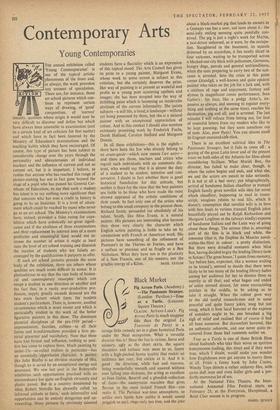Contemporary Arts
Young Contemporaries
THE annual exhibition called 'Young Contemporaries' is one of the typical artistic phenomena of the times and, as always, the work provokes any amount of speculation. There are, for instance, those art school pictures which con- tinue to represent certain ways of drawing, of 'good' composition, of 'correct' tonality, qualities whose origin it would now be very difficult to discover and define but which have always been amenable to examination (and to a certain kind of art criticism for that matter) and which have in fact been fostered by the Ministry of Education's examinations and the teaching habits which they have encouraged. Of course, this type of picture has been subject to considerable change over the years through the personality and idiosyncrasies of individual teachers and the influence of current and not so current art, but it is important, I believe, to realise that anyone who has reached this range of picture-making has not in fact gone beyond the stage of a pupil who has passed his General Cer- tificate of Education; to say that such a student has talent is to say nothing more significant than that someone who has won a credit in history is going to be an historian. It is a level of attain- ment which could be reached by many who never go to an art school. The Ministry's examinations have, indeed, provided a false rating for capa- bilities which have artistically no great signifi- cance and if the abolition of these examinations and their replacement by internal tests of a more profitable and meaningful kind would not in- crease the number of artists it might at least raise the level of art school training and diminish the number of students who are falsely en- couraged by the qualifications it purports to offer.
If such art school pictures provide the main body of the exhibition, there are others whose qualities are much more difficult to assess. It is platitudinous to say that the vast body of .histori- cal and contemporary examples which can tempt a student in one direction or another and the fact that, in a vastly over-productive pro- fession, supply greatly exceeds demand are the two main factors which form the modern student's predicament. There is, however, another circumstance which is more recent and which is particularly evident in the work of the better figurative painters in this show. The dominant pictorial disciplines of the pre-1939 period— impressionism, fauvism, cubism—in all their forms and transformations provided a firm pic- torial grammar and vocabulary. Now that these have lost favour and influence, nothing so posi- tive has come to replace them. Much painting by under-35s—so-called realism in particular—has an essentially opportunist character. A painter like John Bratby is an obvious example of this, though he is saved by an exceptional energy and assurance. We saw last year in the Rebeyrolle exhibition such opportunism practised with an extraordinary but quite un-English virtuosity and plastic power. But in a country dominated by what Robert Melville has shrewdly called 'an informal attitude to form,' such informality and opportunism can be entirely dangerous and un- rewarding. Many pictures by obviously talented
students have a flaccidity which is an expression of this topical mood. The Arts Council has given its prize to a young painter, Margaret Evans, whose work to some extent is subject to this criticism, but she certainly deserves the prize. Her way of painting is at present as wasteful and prolix as a young poet scattering epithets and images; she has been tempted into the way of dribbling paint which is becoming an intolerable platitude of the current informality. She paints subjects—a still life, a head, a landscape—without yet being possessed by them, but she is a natural painter with an exceptional appreciation of colour. And in this context I should also mention extremely promising work by Frederick Fuchs, Derek Holland, Carolyn Stafford and Margaret Dennis.
In all these exhibitions—this is the eighth— there have been the few who already belong to an avant-garde—which now means l'art attire— and there are those, teachers and critics who regard such individuals with an automatic dis- trust, who would say that it is almost the duty of a student to be modest, tentative and con- servative. I doubt in fact whether there is good historical foundation for this attitude, but neither is there for the view that the best painters are liable to be those who have made the most shrewd appraisal of the artistic conditions of their youth. In fact only one of the artists who belong to this small company in the present show, Richard Smith, persuaded me absolutely of his talent. Smith, like Miss Evans, is a natural painter. His pictures are interesting also because they show very clearly the character which English action painting is liable to take on by comparison with French or American work. His pictures have something of the refinement of Pasmore's in the Thirties or Forties, and have a surface as precious and as fragile as a Ben Nicholson. What they have not is the plasticity of a Sam Francis, one of his masters, nor the
graphic energy of a Kline. BASIL TAYLOR










































 Previous page
Previous page